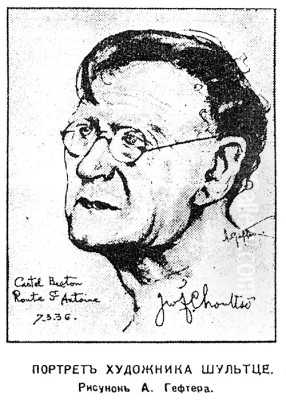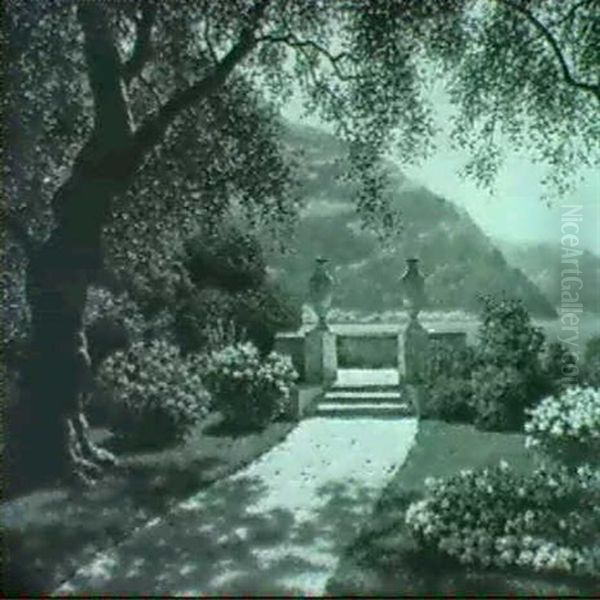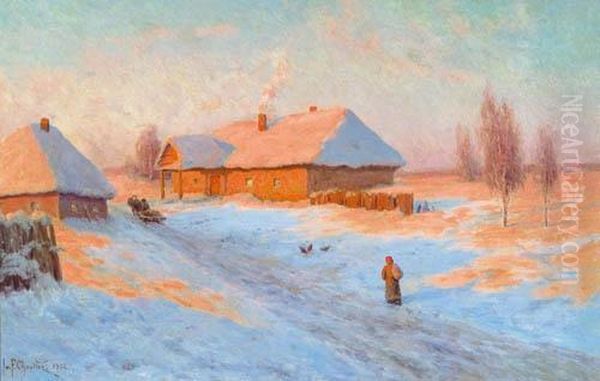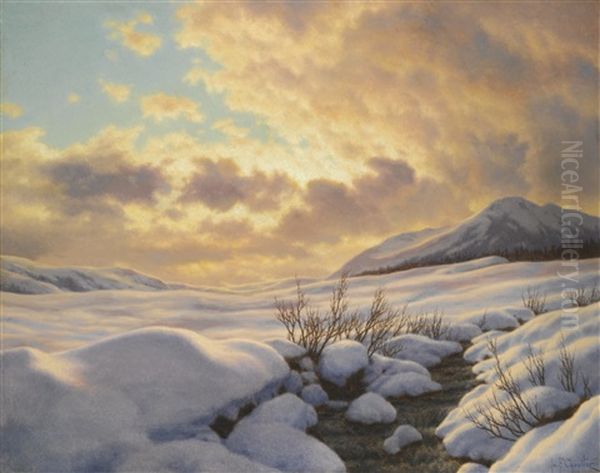
Ivan Fedorovich Choultse stands as a unique figure in the annals of early 20th-century art. A Russian painter of German descent, he dedicated his career almost exclusively to landscape painting, achieving international renown for his extraordinary ability to capture the effects of light, particularly on snow and water. His works, often described as possessing an almost otherworldly luminescence, earned him the moniker "magician of light" and positioned him within a realm often termed "Magical Realism," distinct from the dominant modernist currents of his time. Though he emigrated from Russia after the Revolution, his artistic roots remained deeply embedded in the traditions of Russian Realism, which he elevated through his singular focus on the transient beauty of natural illumination.
Early Life and Artistic Formation in St. Petersburg
Born Ivan Fedorovich Schultze (Иван Фёдорович Шультце) in Saint Petersburg in 1874, his family had German origins, having settled in Russia in the 18th century. While details of his earliest education are sparse, some accounts suggest he initially pursued studies in electrical engineering. However, his true calling lay in art. A pivotal moment came when he began studying under Konstantin Yakovlevich Kryzhitsky (1858-1911), a highly respected landscape painter and a member of the Imperial Academy of Arts. Kryzhitsky became not just a teacher but a mentor, profoundly influencing Choultse's artistic direction.
Kryzhitsky himself was part of a rich tradition of Russian landscape painting that had blossomed in the latter half of the 19th century. Artists like Ivan Shishkin (1832-1898), known for his majestic forest scenes, Isaac Levitan (1860-1900), master of the "mood landscape," and Alexei Savrasov (1830-1897), famous for his lyrical depictions of the Russian countryside, had established landscape as a significant genre reflecting national identity and profound emotional connection to nature. Choultse absorbed these influences, particularly the emphasis on realistic depiction and the evocative power of the natural world.

Under Kryzhitsky's guidance, Choultse honed his technical skills. He learned to observe nature meticulously, paying close attention to the subtle interplay of light and shadow, the texture of snow, the reflection on water, and the structure of trees and terrain. His training emphasized academic precision combined with a sensitivity to atmospheric effects, a foundation that would serve him throughout his career. He began exhibiting around 1903, quickly gaining notice within the St. Petersburg art circles.
Rising Recognition in Pre-Revolutionary Russia
Choultse's talent did not go unnoticed for long. His early exhibitions, possibly starting with one at the Academy of Fine Arts in St. Petersburg around 1903, showcased his burgeoning mastery of landscape. His snow scenes, in particular, began to attract attention for their remarkable verisimilitude and the captivating way he rendered sunlight filtering through trees or glistening on frozen surfaces. This skill resonated with the Russian appreciation for winter landscapes, a recurring theme in the nation's art and literature.
His association with Kryzhitsky provided access to influential circles. There is evidence suggesting Choultse received patronage from members of the Imperial family, including Grand Duchess Olga Alexandrovna, herself an amateur painter, and possibly even Tsar Nicholas II. This Imperial favour marked him as a significant emerging artist within the established art system of Tsarist Russia. He became a member of various artistic societies, further integrating him into the professional art world of the capital.
A significant experience during this period was an Arctic expedition Choultse undertook with Kryzhitsky around 1910. They traveled to Spitsbergen (Svalbard), Norway, exploring the stark beauty of the far north. This journey provided Choultse with new subjects – glaciers, fjords, and the unique light conditions of the Arctic – expanding his repertoire beyond the familiar Russian landscapes. The resulting works likely further enhanced his reputation for capturing extreme and dramatic natural environments.
Another Russian artist whose work resonates with Choultse's fascination with light, albeit with a different stylistic outcome, was Arkhip Kuindzhi (1842-1910). Kuindzhi was celebrated for his almost theatrical depictions of moonlight and sunlight, using bold color contrasts and simplified forms to achieve dramatic effects. While Choultse's approach was more detailed and naturalistic, both artists shared an intense preoccupation with rendering light's mystical and transformative qualities in landscape painting.

The promising trajectory of Choultse's Russian career was deeply affected by the tragic death of his mentor, Konstantin Kryzhitsky, who committed suicide in 1911. This event was a significant personal and professional blow. However, Choultse continued to exhibit and develop his style, participating in exhibitions organized by the society founded in Kryzhitsky's memory and becoming a member of the Society of Artists in St. Petersburg.
Emigration and the Parisian Scene
The Bolshevik Revolution of 1917 and the subsequent Civil War dramatically altered the landscape of Russian society and culture. Like many artists and intellectuals uncomfortable with or endangered by the new regime, Choultse chose to emigrate. Around 1921, after travels through Europe, he settled in Paris, the undisputed center of the Western art world. He adopted the French transliteration of his name, "Choultsé," which is how he became primarily known internationally.
Paris in the early 1920s was a crucible of artistic innovation. Fauvism, Cubism, Surrealism, and various forms of abstraction dominated the avant-garde scene. Artists like Pablo Picasso (1881-1973), Henri Matisse (1869-1954), and Joan Miró (1893-1983) were pushing the boundaries of artistic expression. In this environment, Choultsé’s meticulous, realistic style might have seemed anachronistic. Yet, it was precisely this adherence to a highly refined form of Realism, combined with his unique treatment of light, that allowed him to carve out a successful niche.
He began exhibiting at the prestigious Salon des Artistes Français in 1923 and continued to do so regularly. His works stood in stark contrast to the prevailing modernist trends, offering viewers exquisitely crafted visions of natural beauty, often imbued with a sense of tranquility and wonder that perhaps appealed to audiences weary of war and radical change. His snow scenes, depicting locations in Switzerland and sometimes nostalgic Russian winters, remained a key part of his output, alongside sun-drenched Mediterranean landscapes from the French Riviera and Italy.
Paris was also home to a significant community of Russian émigré artists, including figures like Konstantin Korovin (1861-1939), Alexandre Benois (1870-1960), and Léon Bakst (1866-1924), many associated with the earlier Mir Iskusstva (World of Art) movement. While Choultsé's style differed from the often more decorative or theatrical work of these artists, he was part of this broader diaspora seeking new opportunities in the West. His success demonstrated that traditional representational painting still held considerable appeal.

French critics were generally impressed by Choultsé's technical virtuosity and the captivating atmosphere of his paintings. His ability to render the subtle nuances of light on snow – the pinks of dawn, the golds of sunset, the cool blues of moonlight – was particularly lauded. He quickly established a reputation in his adopted city, finding galleries eager to represent him, such as the Galerie Gérard Frères.
International Acclaim and American Popularity
Choultsé's success was not confined to Paris. His work soon found enthusiastic audiences in London and, most significantly, in the United States. Exhibitions were held at prominent galleries like Arthur Tooth & Sons in London and, notably, the John Levy Galleries and Édouard Jonas in New York City during the late 1920s and early 1930s. These shows were often commercial triumphs.
American collectors, in particular, developed a strong appetite for Choultsé's paintings. His landscapes, especially the luminous snow scenes, resonated with a taste for both technical skill and idealized natural beauty. This appreciation might be seen in the context of American landscape traditions, such as the Hudson River School painters like Albert Bierstadt (1830-1902), who also depicted majestic natural scenes, sometimes with a heightened sense of light and drama (Luminism), although Choultsé's technique and focus were distinct.
His paintings commanded high prices, and his name became synonymous with a certain kind of luxurious, highly finished landscape art. The demand was such that, reportedly, collectors would buy works sight unseen, relying solely on the Choultsé name. This commercial success, while affirming his popularity, sometimes led to criticism that his work catered primarily to wealthy patrons and lacked deeper artistic innovation compared to the modernists.
Despite such critiques, the sheer quality of his execution and the undeniable appeal of his light-filled canvases secured his international standing. He traveled frequently, finding subjects in the Swiss Alps, the Italian lakes, the French Riviera, and recalling the landscapes of his native Russia. Each location offered different opportunities to explore the effects of light under varying conditions – the crisp clarity of Alpine air, the hazy warmth of the Mediterranean sun, the soft glow of snow under moonlight.
His work can also be situated in relation to other European landscape painters who excelled in specific natural effects. For instance, the Swiss painter Alexandre Calame (1810-1864), known for his Alpine scenes, represented an earlier tradition of detailed mountain landscape painting that Choultsé arguably updated with his focus on light. Similarly, Scandinavian painters like the Danish artist Peder Mørk Mønsted (1859-1941) were contemporaries known for their realistic and often idyllic depictions of nature, including snow scenes, providing a parallel tradition of meticulous landscape art.
The Art of Ivan Choultsé: Style and Technique
The defining characteristic of Ivan Choultsé's art is his unparalleled mastery in depicting light. His style is fundamentally rooted in Realism, often pushed to a level of detail that borders on Hyperrealism. However, it transcends mere photographic accuracy through its heightened, almost magical, rendering of light and atmosphere. This quality has led to the term "Magical Realism" being applied to his work, suggesting a reality that is simultaneously precise and enchanted.
Choultsé achieved his effects through meticulous technique. He typically worked with oil on canvas, applying paint smoothly to create highly finished surfaces with little visible brushwork. This allows the viewer to focus entirely on the scene and the play of light within it. His understanding of optics and the behaviour of light was profound. He captured not just direct sunlight or moonlight, but also reflected light, diffused light through mist or clouds, and the subtle colour shifts that occur at different times of day and under various weather conditions.
His snow scenes are perhaps his most famous works. He rendered snow not as a uniform white mass, but as a complex surface reflecting and refracting light, showing textures from powdery drifts to compacted ice, often imbued with delicate hues of pink, violet, gold, or blue depending on the light source. Trees, whether bare winter branches laden with snow or lush summer foliage, were depicted with botanical accuracy, yet always integrated into the overall atmospheric effect.
While often compared to the Impressionists, particularly Claude Monet (1840-1926), for his interest in light, Choultsé's approach differed significantly. Impressionism aimed to capture the fleeting moment and the subjective sensation of light and colour, often using broken brushwork. Choultsé, conversely, sought a more timeless, objective, yet idealized representation. His light feels less like a momentary perception and more like an inherent, almost mystical quality of the scene itself. His work is perhaps closer in spirit, though not in technique, to the aforementioned Arkhip Kuindzhi or certain aspects of Luminism in its intense focus on light's transcendent qualities.
His palette was typically vibrant yet harmonious. Even in scenes dominated by the whites and blues of winter, he introduced subtle warm tones to create balance and depth. In his Mediterranean garden scenes, he employed a richer array of colours to depict blooming flowers and sun-dappled foliage, but always controlled by the unifying effect of the prevailing light. Water, whether frozen rivers or the sparkling Mediterranean Sea, was another element he rendered with exceptional skill, capturing its reflective and transparent properties.
Representative Works
While Choultsé produced a large body of work, certain themes and compositions recur, showcasing his signature style. Specific titles often vary or are descriptive, but key examples illustrate his artistry:
Winter Landscapes (Paysage d'Hiver / Effet de Neige): Numerous paintings fall under this category, often depicting snow-covered forests, fields, or mountain slopes in Russia or Switzerland. A typical example might show sunlight streaming through snow-laden fir trees, casting long blue shadows on the pristine snow, with the snow itself rendered in minute detail, sparkling as if diamond-dusted. Works titled Soleil de Mars (March Sun) often capture the specific quality of late winter light, hinting at the approaching thaw. The feeling is one of profound stillness and crystalline beauty.
Moonlit Winter Nights: Choultsé was also a master of nocturnal scenes. Paintings depicting moonlight on snow are particularly evocative. He captured the cool, silvery light casting ethereal glows and deep shadows, creating an atmosphere of silence and mystery. The snow seems to absorb and radiate the moonlight, transforming the familiar landscape into something magical.
Sunlit Gardens (Jardin Fleuri / Jardin ensoleillé): Contrasting with his winter scenes are his depictions of gardens, often from the French Riviera or Capri. These works burst with colour and warmth. He excelled at showing sunlight filtering through leaves, illuminating vibrant flowers, and reflecting off pathways or water features. Despite the abundance of detail, the unifying effect of the strong sunlight creates a harmonious and inviting scene, often conveying a sense of peaceful abundance.
Alpine Views: His paintings of the Swiss Alps often combine the grandeur of the mountains with his characteristic focus on light. He might depict sunlight catching the high peaks while valleys remain in shadow, or capture the unique atmospheric conditions of mountain environments, emphasizing the clarity of the air and the intensity of the light at high altitudes.
These representative types demonstrate Choultsé's consistent preoccupation with light as his primary subject, regardless of the specific location or season depicted.
Later Years and Legacy
Ivan Choultsé continued to paint and exhibit successfully throughout the late 1920s and into the early 1930s. He maintained his residence primarily in France but traveled for inspiration. His popularity, especially in America, remained high. He passed away in Nice, France, in 1932, at the age of 58 (though some sources incorrectly cite later dates like 1939).
His legacy is somewhat complex. During his lifetime, he achieved significant fame and commercial success, yet he remained largely outside the main narrative of 20th-century art history, which prioritized modernist innovation. His meticulous realism was seen by some critics as conservative or overly commercial. Consequently, for several decades after his death, his work received less scholarly attention compared to his avant-garde contemporaries.
However, his paintings never truly lost their appeal to collectors. His technical brilliance and the sheer beauty of his light-filled landscapes continued to attract admirers. In recent decades, there has been a renewed appreciation for representational painting and artists who excelled within traditions outside of modernism. Choultsé's work is increasingly recognized for its unique qualities and his exceptional skill. His paintings continue to perform well at auction, testament to their enduring visual power.
He can be seen as one of the last great exponents of a certain kind of highly finished, evocative landscape painting rooted in 19th-century traditions but pushed to a unique extreme through his focus on light. While he may not have founded a school or directly influenced major artistic movements, his work stands as a testament to the enduring power of realistic depiction when combined with a singular artistic vision. He remains relevant alongside other 20th-century realists who pursued their own paths, such as the American snowscape specialist Walter Launt Palmer (1854-1932), whose career overlapped Choultsé's and who also focused intently on the effects of light on snow, albeit with a different, more distinctly American Impressionist-influenced style.
Conclusion
Ivan Fedorovich Choultsé, the "magician of light," occupies a distinct and fascinating place in art history. Emerging from the rich tradition of Russian landscape painting under the tutelage of Konstantin Kryzhitsky, he developed a highly personal style characterized by meticulous realism and an extraordinary sensitivity to the nuances of natural light. His snow scenes, in particular, possess an almost supernatural luminescence, capturing the crisp air of winter and the dazzling effects of sun or moon on snow with unparalleled virtuosity.
Forced to leave Russia after the Revolution, he found remarkable success in Paris, London, and especially America, demonstrating the continued appeal of finely crafted representational art even amidst the ferment of modernism. While sometimes criticized for conservatism or commercialism, the enduring popularity of his work and the growing recognition of his technical mastery affirm his significance. Choultsé remains a compelling figure, an artist who dedicated his life to capturing the transient magic of light on the enduring forms of the natural world, leaving behind a legacy of landscapes that continue to enchant viewers with their luminous beauty.